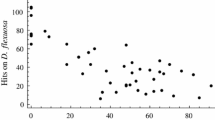Abstract
Vegetation changes during succession can be regarded as plant-to-plant replacement processes. For deeper insight into the nature of these process we need to investigate the mechanisms involved. Therefore two experiments with herbaceous plant communities were analyzed. The data confirm the view that all three types of interaction: competition, coexistence by niche separation, and cooperation, act together. Likewise it can be concluded that the three models of succession proposed by Connell & Slatyer (1977) are not exclusive but describe mechanisms acting together in the same succession process. Evidence is given that seasonal events can act like a switch and influence the successional trend at a later time. It is, therefore, not meaningful to differentiate between fluctuations in the sense of yearly oscillations and the successional trend itself.
Similar content being viewed by others
References
Bornkamm R. 1962. Über die Rolle der Durchdringungsge-schwindigkeit bei Kleinsukzessionen. Veröff. Geobot. Inst. Rübel 37: 16–26.
Bornkamm R. 1974. Zur Konkurrenzkraft von Bromus erectus II. Ein zwanzigjähriger Dauerversuch. Bot. Jahrb. Syst. 94: 391–412.
Bornkamm R. 1985. Vegetation changes in herbaceous communities. Handb. Veget. Sci. 3: 89–109.
Bornkamm R. 1986. Ruderal succession starting at different seasons. Acta Soc. Botan. Pol. 55: 403–419.
Bornkamm R. 1987. Veränderungen der Phytomasse in den ersten zwei Jahren nach einer Sukzession auf unterschiedlichen Böden. Flora 179: 179–192.
Connell J. H. & Slatyer R. O. 1977. Mechanisms of succession in natural communities and their role in community stability and organization. Am. Nat. 111: 1119–1144.
Cramer W. & Hytteborn H. 1987. The separation of fluctuation and long-term change in vegetation dynamics of a rising seashore. Vegetatio 69: 157–167.
Debussche M., Godron M., Lepart J. & Romane F. 1977. An account of the use of a transition matrix. Agro-Ecosystems 3: 81–92.
Egler F. 1954. Vegetation science concepts. I. Initial floristic composition, a factor in old-field vegetation development. Vegetatio 4: 412–417.
Hayashi I. 1977. Secondary succession of herbaceous communities in Japan. Jap. J. Ecol. 27: 191–200.
Hils M. H. & Vankat J. L. 1982. Species removals from a firstyear old-field plant community. Ecology 63: 705–711.
Horn H. S. 1974. The ecology of secondary succession. Ann. Rev. Ecol. Syst. 5: 25–37.
Knapp R. 1974. Some principles of classification and of terminology in successions. Handb. Veget. Sci. 8: 169–177.
Lippe E., de Smidt J. T. & Glenn-Lewin D. C. 1985. Markov models and succession: A test from a heathland in the Netherlands. J. Ecol. 73: 775–791.
Miles J. 1979. Vegetation dynamics. Chapman & Hall, London.
Rabotnov T. A. 1966. Peculiarities of the structure of polydominant meadow communities. Vegetatio 13: 109–116.
Usher M. B. 1979. Markovian approaches to ecological succession. J. Animal Ecol. 48: 413–426.
Usher M. B. 1980. Modelling ecological succession with particular reference to Markovian models. Vegetatio 46: 11–18.
van Dorp D., Boot R. & van der Maarel E. 1985. Vegetation succession on the dunes near Oostvoorne, The Netherlands, since 1934, interpreted from air photographs and vegetation maps. Vegetatio 58: 125–136.
van Hulst R. 1987. Invasion models of vegetation dynamics. Vegetatio 69: 123–131.
van der Maarel E. & Werger M. J.A. 1980. On the treatment of succession data. Phytocoenosis (Warszawa-Bialowieza) 7: 257–278.
van Tongeren O. & Prentice I. C. 1986. A spatial model for vegetation dynamics. Vegetatio 65: 163–173.
Author information
Authors and Affiliations
Additional information
Dedicated to Prof. Dr Dr h.c. Heinrich Walter on the occasion of the 90th anniversary of his birthday.
Rights and permissions
About this article
Cite this article
Bornkamm, R. Mechanisms of succession on fallow lands. Vegetatio 77, 95–101 (1988). https://doi.org/10.1007/BF00045755
Accepted:
Issue Date:
DOI: https://doi.org/10.1007/BF00045755




